
Beechcraft Bonanza
Unanswered Questions
Discussions
Encyclopedia
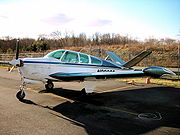
.jpg)
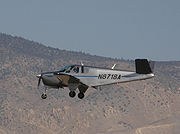
General aviation
General aviation is one of the two categories of civil aviation. It refers to all flights other than military and scheduled airline and regular cargo flights, both private and commercial. General aviation flights range from gliders and powered parachutes to large, non-scheduled cargo jet flights...
aircraft introduced in 1947 by The Beech Aircraft Corporation
Beechcraft
Beechcraft is an American manufacturer of general aviation and military aircraft, ranging from light single engine aircraft to business jets and light military transports. Previously a division of Raytheon, it has been a brand of Hawker Beechcraft since 2006....
of Wichita, Kansas
Wichita, Kansas
Wichita is the largest city in the U.S. state of Kansas.As of the 2010 census, the city population was 382,368. Located in south-central Kansas on the Arkansas River, Wichita is the county seat of Sedgwick County and the principal city of the Wichita metropolitan area...
. , it is still being produced by Hawker Beechcraft
Hawker Beechcraft
Hawker Beechcraft Corporation is an aerospace manufacturing company that builds the Beechcraft and Hawker business jet lines of aircraft....
, and has been in continuous production longer than any other airplane in history. More than 17,000 Bonanzas of all variants have been built.
Design and development
At the end of World War IIWorld War II
World War II, or the Second World War , was a global conflict lasting from 1939 to 1945, involving most of the world's nations—including all of the great powers—eventually forming two opposing military alliances: the Allies and the Axis...
, two all-metal aircraft emerged, the Model 35 Bonanza and the Cessna 195
Cessna 195
The Cessna 190 and 195 Businessliner are a family of light single radial engine powered, conventional landing gear equipped, general aviation aircraft which were manufactured by Cessna between 1947 and 1954....
, that represented very different approaches to the premium-end of the postwar civil aviation market. With its high wing, seven-cylinder radial engine
Radial engine
The radial engine is a reciprocating type internal combustion engine configuration in which the cylinders point outward from a central crankshaft like the spokes on a wheel...
, fixed tailwheel undercarriage
Conventional landing gear
thumb|The [[Piper PA-18|Piper Super Cub]] is a popular taildragger aircraft.thumb|right|A [[Cessna 150]] converted to taildragger configuration by installation of an after-market modification kit....
and roll-down side windows, the Cessna 195 was little more than a continuation of prewar technology; the 35 Bonanza, however, was more like the fighters developed during the war, featuring an easier-to-manage horizontally-opposed six cylinder engine, a rakishly streamlined
Streamliner
A streamliner is a vehicle incorporating streamlining in a shape providing reduced air resistance. The term is applied to high-speed railway trainsets of the 1930s to 1950s, and to their successor "bullet trains". Less commonly, the term is applied to fully faired recumbent bicycles...
shape, retractable nosewheel undercarriage (although the nosewheel initially was not steerable, or castering) and low-wing configuration.
Designed by a team led by Ralph Harmon, the model 35 Bonanza was a relatively fast, low-wing monoplane at a time when most light aircraft
Aircraft
An aircraft is a vehicle that is able to fly by gaining support from the air, or, in general, the atmosphere of a planet. An aircraft counters the force of gravity by using either static lift or by using the dynamic lift of an airfoil, or in a few cases the downward thrust from jet engines.Although...
were still made of wood and fabric. The Model 35 featured retractable landing gear
Undercarriage
The undercarriage or landing gear in aviation, is the structure that supports an aircraft on the ground and allows it to taxi, takeoff and land...
, and its signature V-tail
V-tail
In aircraft, a V-tail is an unconventional arrangement of the tail control surfaces that replaces the traditional fin and horizontal surfaces with two surfaces set in a V-shaped configuration when viewed from the front or rear of the aircraft...
(equipped with a combination elevator-rudder called a ruddervator), which made it both efficient and the most distinctive private aircraft in the sky. The prototype 35 Bonanza made its first flight on 22 December 1945, with the first production aircraft debuting as 1947 models. The first 30–40 Bonanzas produced had fabric-covered flaps and ailerons, after which, those surfaces were covered with magnesium
Magnesium
Magnesium is a chemical element with the symbol Mg, atomic number 12, and common oxidation number +2. It is an alkaline earth metal and the eighth most abundant element in the Earth's crust and ninth in the known universe as a whole...
alloy sheet.
In 1982 the production of the V-tail Bonanza stopped but the conventional-tail Model 33 continued in production until 1995. Still built today is the Model 36 Bonanza, a longer-bodied, straight-tail variant of the original design, introduced in 1968.
All Bonanzas share an unusual feature: The yoke and rudder pedals are interconnected by a system of bungee cord
Bungee cord
A bungee cord , also known as a shock cord, is an elastic cord composed of one or more elastic strands forming a core, usually covered in a woven cotton or polypropylene sheath...
s that assist in keeping the airplane in coordinated flight
Coordinated flight
In aviation, coordinated flight of an aircraft is flight without sideslip.When an aircraft is flying with zero sideslip a turn and bank indicator installed on the aircraft’s instrument panel usually shows the ball in the center of the spirit level...
during turns. The bungee system allows the pilot to make coordinated turns using the yoke alone, or with minimal rudder input, during cruise flight. Increased right-rudder pressure is still required on takeoff to overcome torque
Torque
Torque, moment or moment of force , is the tendency of a force to rotate an object about an axis, fulcrum, or pivot. Just as a force is a push or a pull, a torque can be thought of as a twist....
and P-factor
P-factor
P-factor, also known as asymmetric blade effect and asymmetric disc effect, is an aerodynamic phenomenon experienced by a moving propeller, that is responsible for asymmetrical relocation of the propeller's center of thrust when aircraft is at a high angle of attack.- Causes :When an aircraft is in...
. In the landing phase, the bungee system must be overridden by the pilot when making crosswind landing
Crosswind landing
A crosswind landing is a landing maneuver in which a significant component of the prevailing wind is perpendicular to the runway center line.-Significance:Aircraft in flight are subject to the direction of the winds in which the aircraft is operating...
s, which require cross-controlled
Slip (aerodynamic)
A slip is an aerodynamic state where an aircraft is moving somewhat sideways as well as forward relative to the oncoming airflow. In other words, for a conventional aircraft, the nose will not be pointing directly into the relative wind .A slip is also a piloting maneuver where the pilot...
inputs to keep the nose of the airplane aligned with the runway center line without drifting left or right. This feature started with the V-tail and persists on the current production model.
The twin-engine variant of the Bonanza is called the Baron
Beechcraft Baron
|-See also:- Further reading :*Harding, Stephen. U.S. Army Aircraft Since 1947. Shrewsbury, UK:Airlife Publishing, 1990. ISBN 1-85310-102-8.*Michell, Simon. Jane's Civil and Military Aircraft Upgrades 1994-95. Coulsdon, UK:Jane's Information Group, 1994. ISBN 0-7106-1208-7.*Taylor, John W. R....
, whereas the Twin Bonanza
Beechcraft Twin Bonanza
|-See also:-References:Twin Bonanza Association http://twinbonanza.com...
is a different design and not based on the original single-engine Bonanza fuselage.
QU-22 Pave Eagle
The QU-22 was a Beech 36/A36 Bonanza modified during the Vietnam WarVietnam War
The Vietnam War was a Cold War-era military conflict that occurred in Vietnam, Laos, and Cambodia from 1 November 1955 to the fall of Saigon on 30 April 1975. This war followed the First Indochina War and was fought between North Vietnam, supported by its communist allies, and the government of...
to be an electronic monitoring signal relay aircraft, developed under the project name "Pave Eagle" for the United States Air Force
United States Air Force
The United States Air Force is the aerial warfare service branch of the United States Armed Forces and one of the American uniformed services. Initially part of the United States Army, the USAF was formed as a separate branch of the military on September 18, 1947 under the National Security Act of...
. A reduction geared Continental IO-520 engine was used to reduce its noise signature, much like the later Army-Lockheed YO-3A
Army-Lockheed YO-3A
The Lockheed YO-3 "Quiet Star" was an American single-engined, propeller-driven monoplane that was developed for battlefield observation during the Vietnam War. It was designed to be as quiet as possible, and was intended to observe troop movements in near-silence during hours of darkness.-Design...
. These aircraft were intended to be used as unmanned drones to monitor sensors along the Ho Chi Minh Trail
Ho Chi Minh trail
The Ho Chi Minh trail was a logistical system that ran from the Democratic Republic of Vietnam to the Republic of Vietnam through the neighboring kingdoms of Laos and Cambodia...
in Laos
Laos
Laos Lao: ສາທາລະນະລັດ ປະຊາທິປະໄຕ ປະຊາຊົນລາວ Sathalanalat Paxathipatai Paxaxon Lao, officially the Lao People's Democratic Republic, is a landlocked country in Southeast Asia, bordered by Burma and China to the northwest, Vietnam to the east, Cambodia to the south and Thailand to the west...
and report troop and supply movements. When the project was put into operation in 1968, however, the drones were all flown by pilots of the 554th Reconnaissance Squadron.
Six YQU-22A prototypes (modifications of the Beech 33 Debonair) were combat-tested in 1968, and two were lost during operations, with a civilian test pilot killed. Twenty-seven QU-22Bs were modified, 13 in 1969 and 14 in 1970, with 6 lost in combat. Two Air Force pilots were killed in action. All of the losses were due to engine failures or effects of turbulence.
Model 33 Debonair/Bonanza (BE33)
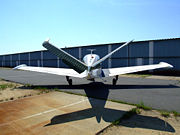
Continental O-470
The Continental O-470 engine is a family of carbureted six-cylinder, horizontally opposed, air-cooled aircraft engines that was developed especially for use in light aircraft by Continental Motors. The family includes the E165, E185 and the E225 engines...
, 233 built
35-A33 Debonair Model 33 with rear side windows and improved interior trim, 154 built
35-B33 Debonair A33 with contoured fin leading edge, N35 fuel tank modifications and P35 instrument panel, 426 built
35-C33 Debonair B33 with teardrop rear side windows, enlarged fin fairing and improved seats, 305 built
35-C33A Debonair C33 with a 285hp Continental IO-520-B engine and optional fifth seat, 179 built
D33 Debonair
- One S35 modified as a military close-support prototype
E33 Bonanza C33 with improved Bonanza trim, 116 built
E33A Bonanza E33 with a 285hp Continental IO-520-B engine, 85 built
E33B Bonanza
- E33 with strengthened airframe and certified for aerobatics
E33C Bonanza E33B with a 285hp Continental IO-520-B engine, 25 built
F33 Bonanza E33 with deeper rear side windows and minor improvements, 20 built
F33A Bonanza F33 with a 285hp Continental IO-520-B engine, later aircraft have a longer S35/V35 cabin and extra seats, 821 built
F33C Bonanza F33A certified for aerobatics, 118 built
G33 Bonanza F33 with a 260hp Continental IO-470-N engine and V35B trim, 50 built
Model 35 Bonanza (BE35)
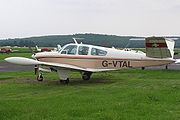
(1947–1948), main production with 165 hp Continental E-185-1 engine, 1500 built
A35 Model 35 with higher take-off weight, and minor internal changes, 701 built
B35 A35 with a 165hp Continental E-185-8 engine and other minor changes, 480 built
C35 B35 with a 185hp Continental E-185-11 engine, metal propeller, larger tail surfaces and higher take-off weight, 719 built
D35 C35 with increased take-off weight and minor changes, 298 built
E35 D35 with optional E-225-8 engine and minor changes, 301 built
F35 E35 with extra rear window each side, 392 built
G35 F35 with a Continental E-225-8 engine, 476 built
H35
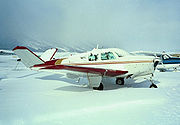
J35 H35 with a fuel injected Continental IO-470-C engine, optional autopilot and improved instruments, 396 built
K35 J35 with fuel load increase, optional fifth seat and increased take-off weight, 436 built
M35 K35 with cambered wingtips and minor changes, 400 built
N35 M35 with a 260hp Continental IO-470-N engine, increased fuel capacity, increased take-off weight and teardrop rear side windows, 280 built
035 Experimental version, an N35 fitted with laminar flow airfoil and redesigned landing gear; only one built
P35 N35 with new instrument panel and improved seating, 467 built
S35 P35 with a Continental IO-520-B engine, higher take-off weight, longer cabin interior, optional fifth and sixth seat, 667 built
V35 S35 with higher take-off weight, single-piece windshield, optional turbocharged TSIO-520-D engine (as V35-TC), 873 built
V35A V35 with a streamlined windshield and minor changes, optional turbocharged TSIO-520-D engine (as V35A-TC), 470 built
V35B V35A with minor improvements to systems and trim, optional turbocharged TSIO-520-D engine (as V35B-TC), 873 built
Model 36 Bonanza (BE36)
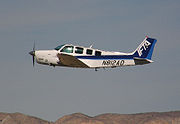
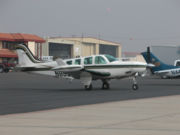
A36 Model 36 with improved deluxe interior, a new fuel system, higher take-off weight, from 1984 fitted with a Continental IO-550-BB
Continental IO-550
The Continental IO-550 engine is a large family of fuel injected six-cylinder, horizontally opposed, air-cooled aircraft engines that were developed for use in light aircraft by Teledyne Continental Motors...
engine and redesigned instrument panel and controls, 2128 built
A36TC Model 36 with a 3-bladed propeller and a 300hp turbocharged Continental TSIO-520-UB engine, 280 built
T36TC A36 fitted with T-tail and a 325hp Continental TSIO-520 engine, one built
B36TC A36TC with longer span wing, increased range, redesigned instrument panel and controls, higher take-off weight, 116 built
G36 – glass cockpit
Glass cockpit
A glass cockpit is an aircraft cockpit that features electronic instrument displays, typically large LCD screens, as opposed to the traditional style of analog dials and gauges...
update of the A36 with the Garmin G1000
Garmin G1000
The Garmin G1000 is an integrated flight instrument system manufactured by Garmin typically composed of two display units, one serving as a primary flight display, and one as a multi-function display...
system.
QU-22
YQU-22A (Model P.1079)- USAF military designation for a prototype intelligence-gathering drone version of the Bonanza 36, six built
YAU-22A (Model PD.249)
- Prototype low-cost close-support version using Bonanza A36 fuselage and Baron B55 wings, one built
QU-22B
- Production drone model for the USAF operation Pave Eagle, 27 built
Modifications
Propjet Bonanza (A36)- standard aircraft modified by Tradewind Turbines with an AllisonAllison Engine CompanyThe Allison Engine Company was a U.S. aircraft engine manufacturer. In 1929, shortly after the death of James Allison, the company was purchased by the Fisher brothers. Fisher sold the company to General Motors, who owned it for most of its history...
250Rolls-Royce Model 250|-External links:*...
-B17F/2 turbopropTurbopropA turboprop engine is a type of turbine engine which drives an aircraft propeller using a reduction gear.The gas turbine is designed specifically for this application, with almost all of its output being used to drive the propeller...
engine (Original STCSupplemental Type CertificateA Supplemental Type Certificate is an FAA approved major modification or repair to an existing type certified aircraft, engine or propeller. As it adds to the existing type certificate, it is deemed 'supplemental'.-Purpose:...
by Soloy).
Turbine Air Bonanza
- B36TC modified by West Pacific Air, LLC and Rocket Engineering with a Pratt & Whitney PT6A-21Pratt & Whitney Canada PT6The Pratt & Whitney Canada PT6 is one of the most popular turboprop aircraft engines in history, and is produced by Pratt & Whitney Canada. The PT6 family is particularly well known for its extremely high reliability, with MTBO's on the order of 9000 hours in some models. In US military use, they...
turbopropTurbopropA turboprop engine is a type of turbine engine which drives an aircraft propeller using a reduction gear.The gas turbine is designed specifically for this application, with almost all of its output being used to drive the propeller...
engine
Whirlwind System II Turbonormalized Bonanza (36, A36, G36)
- standard aircraft modified by Tornado Alley Turbo with a Tornado Alley Turbonormalizing system and approved for a 4000 lb MTOW
Whirlwind TCP Bonanza (A36TC or B36TC)
- standard aircraft modified by Tornado Alley Turbo with a TCM IO-550BContinental IO-550The Continental IO-550 engine is a large family of fuel injected six-cylinder, horizontally opposed, air-cooled aircraft engines that were developed for use in light aircraft by Teledyne Continental Motors...
engine and Tornado Alley Turbonormalizing system, this airframe is approved for a 4042 lb MTOW.
Bay Super V
- A multiengine conversion of the C35 Bonanza
Model 40
The Beechcraft Model 40A was an experimental twin-engined aircraft based on the Bonanza. Only one prototype was built in 1948. It featured a unique over/under arrangement of two 180 hp FranklinFranklin Engine Company
The Franklin Engine Company was a manufacturer of aircraft engines, formed as the H. H. Franklin Co. in 1902, located in Syracuse, New York, United States. Barely surviving bankruptcy in 1933, the company was purchased by a group of ex-employees and renamed Aircooled Motors in 1937...
engines mounted on top of each other and driving a single propeller. The plane had a different engine cowl from a standard Bonanza, and the nose gear could not fully retract, but otherwise it greatly resembled the production Bonanzas of the time. Certification rules
Type certificate
A Type Certificate, is awarded by aviation regulating bodies to aerospace manufacturers after it has been established that the particular design of a civil aircraft, engine, or propeller has fulfilled the regulating bodies' current prevailing airworthiness requirements for the safe conduct of...
demanded a firewall be fitted between the two engines, however, thus stopping development. The status of the prototype is unknown.
Parastu
This is the standard F33 (1970) variant of the Bonanza IranIran
Iran , officially the Islamic Republic of Iran , is a country in Southern and Western Asia. The name "Iran" has been in use natively since the Sassanian era and came into use internationally in 1935, before which the country was known to the Western world as Persia...
has reverse engineered, and is manufacturing without a license.
Civil
The Bonanza is popular with air charter companies, and is operated by private individuals and companies.Military
 Haiti
Haiti
- Armed Forces of HaitiArmed Forces of HaitiThe Armed Forces of Haiti, , consisted of the Haitian Army, Haitian Navy , Haitian Coast Guard, the Haitian Air Force, and some police forces . The Army was always the dominant service with the others serving primarily in a support role...
- Imperial Iranian Air Force
- Israeli Air ForceIsraeli Air ForceThe Israeli Air Force is the air force of the State of Israel and the aerial arm of the Israel Defense Forces. It was founded on May 28, 1948, shortly after the Israeli Declaration of Independence...
 Indonesia
Indonesia Côte d'Ivoire
Côte d'Ivoire Nicaragua
Nicaragua Paraguay
Paraguay- United States Air ForceUnited States Air ForceThe United States Air Force is the aerial warfare service branch of the United States Armed Forces and one of the American uniformed services. Initially part of the United States Army, the USAF was formed as a separate branch of the military on September 18, 1947 under the National Security Act of...
Notable flights
- In January 1949, the fourth Bonanza to come off the production line was piloted by Captain William Odom from Honolulu, HawaiiHonolulu, HawaiiHonolulu is the capital and the most populous city of the U.S. state of Hawaii. Honolulu is the southernmost major U.S. city. Although the name "Honolulu" refers to the urban area on the southeastern shore of the island of Oahu, the city and county government are consolidated as the City and...
to the continental United States (2,900 statute miles), the first light airplane to do so. The airplane was called "Waikiki Beech", and its 40-gallon (150 L) fuel capacity was increased (using fuselage and wing tanks) to 268 gallons (1010 L), which gave a still-air range of nearly 5,000 statute miles. - In March 1949, Captain Odom piloted "Waikiki Beech" a distance of 5273 miles (8,486 km) from Honolulu to Teterboro, New JerseyTeterboro, New JerseyTeterboro is a borough in Bergen County, New Jersey, United States. As of the 2010 United States Census, the borough population was 67, making it the fourth smallest municipality, by population, in New Jersey....
, setting a nonstop record. The flight time was 36:01 hours, at an average speed of 146.3 miles per hour (65.4 m/s), consuming 272.25 gal of fuel. After that flight, the airplane was donated to the Smithsonian InstitutionSmithsonian InstitutionThe Smithsonian Institution is an educational and research institute and associated museum complex, administered and funded by the government of the United States and by funds from its endowment, contributions, and profits from its retail operations, concessions, licensing activities, and magazines...
's National Air Museum, as the National Air and Space MuseumNational Air and Space MuseumThe National Air and Space Museum of the Smithsonian Institution holds the largest collection of historic aircraft and spacecraft in the world. It was established in 1976. Located in Washington, D.C., United States, it is a center for research into the history and science of aviation and...
was then called. - On 7 October 1951, an American congressman from IllinoisIllinoisIllinois is the fifth-most populous state of the United States of America, and is often noted for being a microcosm of the entire country. With Chicago in the northeast, small industrial cities and great agricultural productivity in central and northern Illinois, and natural resources like coal,...
, Peter F. Mack, Jr.Peter F. Mack, Jr.Peter Francis Mack, Jr. was a U.S. Representative from Illinois.Born in Carlinville, Illinois, Mack attended the public schools and Blackburn College in Carlinville, Illinois, and St. Louis University....
, began an around-the-world trip in "Waikiki Beech", on loan from the Museum and reconditioned at the Beech factory, and renamed "Friendship Flame". He spent 15 weeks traveling through 30 countries (223 hours flight time). The plane was again refurbished in 1975 and returned to the National Air and Space Museum. It is still on display there, with both names painted on its sides.
Accidents and incidents
- On 3 February 1959, Buddy HollyBuddy HollyCharles Hardin Holley , known professionally as Buddy Holly, was an American singer-songwriter and a pioneer of rock and roll...
, Ritchie ValensRitchie ValensRitchie Valens was a Mexican-American singer, songwriter and guitarist....
, The Big BopperThe Big BopperJiles Perry "J. P." Richardson, Jr. also commonly known as The Big Bopper, was an American disc jockey, singer, and songwriter whose big voice and exuberant personality made him an early rock and roll star...
, as well as the pilot Roger PetersonRoger Peterson (pilot)Roger Arthur Peterson was a 21-year-old pilot of the aircraft whose crash took the lives of rock and roll musicians Buddy Holly, Ritchie Valens and J.P. "The Big Bopper" Richardson as well as himself...
died when their Beechcraft Bonanza 35, registration N3794N, crashed shortly after takeoff, at night and in bad weather. This accident has become known as The Day the Music DiedThe Day the Music DiedOn February 3, 1959, a small-plane crash near Clear Lake, Iowa, killed three American rock and roll pioneers: Buddy Holly, Ritchie Valens, and J. P. "The Big Bopper" Richardson, as well as the pilot, Roger Peterson. The day was later called The Day the Music Died by Don McLean, in his song...
. - On July 31, 1964, country music star Jim ReevesJim ReevesJames Travis Reeves , better known as Jim Reeves, was an American country and popular music singer-songwriter. With records charting from the 1950s to the 1980s, he became well-known for being a practitioner of the Nashville sound...
and his pianist Dean Manuel died when the Beechcraft Debonair Reeves was piloting crashed in the Brentwood area of Nashville during a violent thunderstorm. The wreckage and bodies were discovered on 2 August 1964 amid dense foliage in a wooded area just off Baxter Lane next to US Interstate 65Interstate 65Interstate 65 is a major Interstate Highway in the United States. The southern terminus is located at an intersection with Interstate 10 in Mobile, Alabama, and its northern terminus is at an interchange with Interstate 90 , U.S. Route 12, and U.S...
. - In February 1981, Apple ComputerApple ComputerApple Inc. is an American multinational corporation that designs and markets consumer electronics, computer software, and personal computers. The company's best-known hardware products include the Macintosh line of computers, the iPod, the iPhone and the iPad...
cofounder Steve WozniakSteve WozniakStephen Gary "Woz" Wozniak is an American computer engineer and programmer who founded Apple Computer, Co. with Steve Jobs and Ronald Wayne...
crashed his Beechcraft Bonanza while taking off from Santa Cruz Sky Park. The NTSB investigation revealed Wozniak did not have a "high performance" endorsement (making him legally unqualified to operate the airplane) and had a "lack of familiarity with the aircraft." The cause of the crash was determined to be a premature liftoff, followed by a stall and "mush" into a 12-foot embankment. Wozniak later made a full recovery, albeit with a case of temporary retrograde amnesiaRetrograde amnesiaRetrograde amnesia is a loss of access to events that occurred, or information that was learned, before an injury or the onset of a disease....
. - On 19 March 1982, Ozzy OsbourneOzzy OsbourneJohn Michael "Ozzy" Osbourne is an English vocalist, whose musical career has spanned over 40 years. Osbourne rose to prominence as lead singer of the pioneering English heavy metal band Black Sabbath, whose radically different, intentionally dark, harder sound helped spawn the heavy metal...
guitarist Randy RhoadsRandy RhoadsRandall William "Randy" Rhoads was an American heavy metal guitarist who played with Ozzy Osbourne and Quiet Riot. A devoted student of classical guitar, Rhoads often combined his classical music influences with his own heavy metal style. While on tour with Ozzy Osbourne, he would seek out...
was killed when the wing of the Bonanza F35 he was riding in clipped Ozzy's tour bus and crashed into a nearby mansion garage. The pilot and another passenger were also killed. - On 13 March 2006, game show host Peter TomarkenPeter TomarkenPeter David Tomarken was an American television personality primarily known as the host of Press Your Luck.-Early life:...
crashed his Bonanza A36 into Santa Monica Bay during climb-out from the Santa Monica Airport in California. He was en route to San Diego to pick up a cancer patient who needed transportation to UCLA Medical Center for treatment. Tomarken and his wife were killed in the crash.

